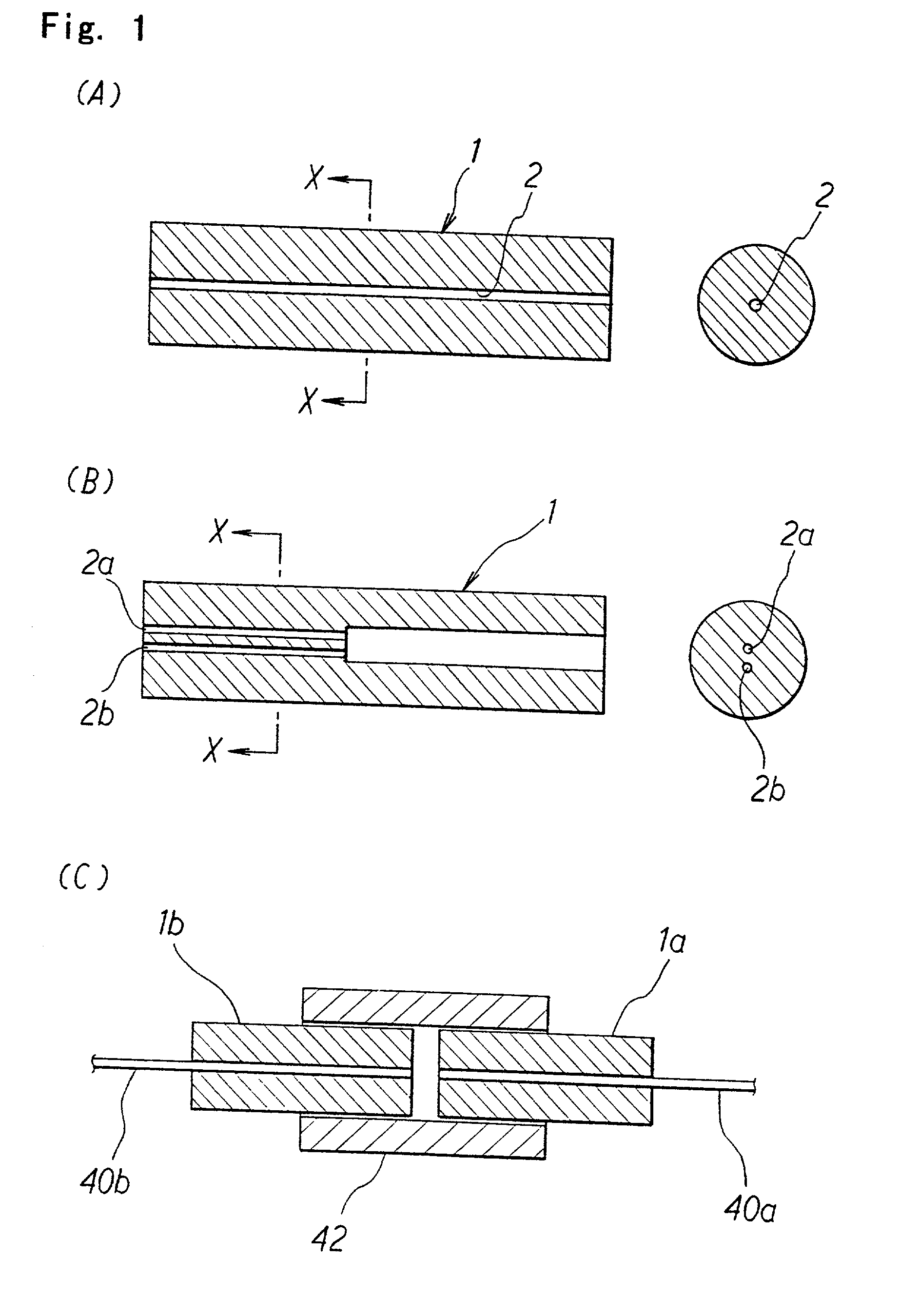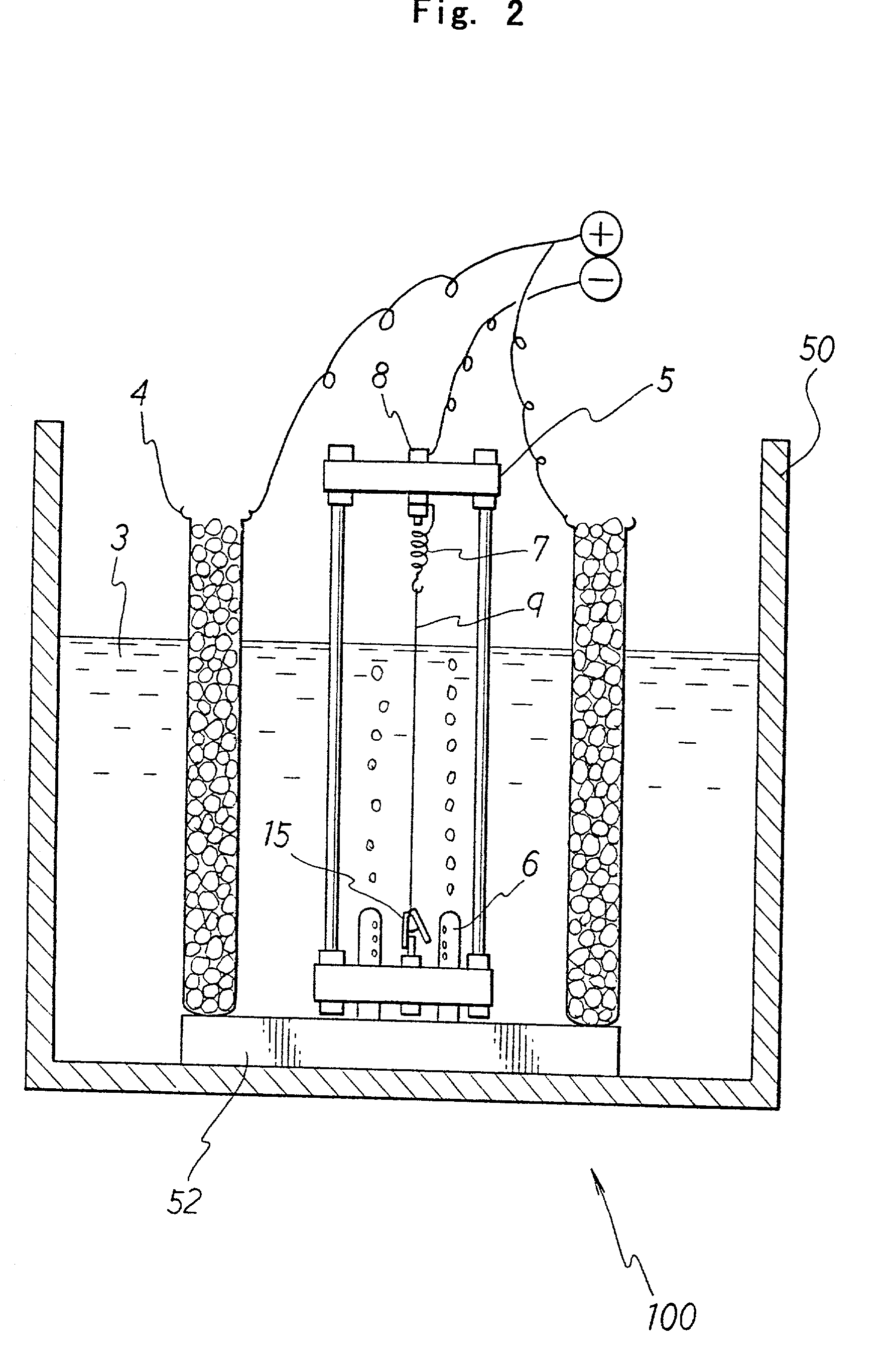Optical fiber connector, ferrule used therefor and method for manufacturing ferrule
a technology of optical fiber connectors and ferrules, applied in the direction of electrolysis processes, instruments, electroforming processes, etc., can solve the problems of laborious polishing process, decreased productivity, and difficult to obtain a perfectly uniform inner diameter concerning
- Summary
- Abstract
- Description
- Claims
- Application Information
AI Technical Summary
Benefits of technology
Problems solved by technology
Method used
Image
Examples
first embodiment
[0078] First Embodiment
[0079] An aluminum alloy wire (alloy of copper, magnesium, and aluminum) of .phi.=0.126 mm having a circular cross section was prepared. The wire was set to the jig 5 in a state of being stretched in the vertical direction by means of the elasticity of the spring 7 as shown in (A) of FIG. 3. The surface of the alloy wire was degreased by sufficiently wiping the surface of the alloy wire with gauze immersed with petroleum benzine. An electroforming solution 3 containing a major component of nickel sulfamate was charged in the electroforming bath 50 shown in FIG. 2. The four anodes 4, which were composed of nickel balls placed in a net made of titanium enclosed in a polyester bag, were installed at the four corners of the base 52 around the center of the wire member 9. The electroforming bath was heated to obtain a temperature of 55.+-.5.degree. C. while performing high speed filtration at a filtration accuracy of 1 .mu.m. The jig 5 attached with the aluminum al...
second embodiment
[0081] Second Embodiment
[0082] A wire member 9 composed of SUS 304 of .phi.=0.126 mm having a circular cross section was prepared, and the wire member 9 was set to the jig 5 in the same manner as in the first embodiment. As shown in FIG. 7, the wire member 9 was covered with a vinyl adhesive tape 20 at intervals of 40 mm. The jig 5 was washed with water, and then it was degreased and washed with water. After that, a mold release treatment was applied by immersing the wire member 9 at room temperature for 10 minutes in an aqueous solution of a mixture of commercially available Nikkanon Tack A, B produced by Nihon Kagaku Sangyo Co., Ltd. Subsequently, the wire member 9 was sufficiently washed with water, and then the electroforming was performed at 9 A / dm.sup.2 for one day in the same manner as in the first embodiment to obtain a nickel electroformed product having a thickness of .phi.=about 3 mm in average. The electroformed product was set to an extracting jig 24 formed with a throu...
third embodiment
[0083] Third Embodiment
[0084] An aluminum alloy wire having an elliptic cross section as shown in (A) of FIG. 5 was prepared. The aluminum alloy wire was an oval having a cross section with a minor axis of 0.126 mm and a major axis of 0.252 mm. The electroforming was performed with the aluminum alloy wire in the same manner as explained in the first embodiment. As a result, a two-core type ferrule was successfully obtained.
PUM
| Property | Measurement | Unit |
|---|---|---|
| diameter | aaaaa | aaaaa |
| length | aaaaa | aaaaa |
| temperature | aaaaa | aaaaa |
Abstract
Description
Claims
Application Information
 Login to View More
Login to View More - Generate Ideas
- Intellectual Property
- Life Sciences
- Materials
- Tech Scout
- Unparalleled Data Quality
- Higher Quality Content
- 60% Fewer Hallucinations
Browse by: Latest US Patents, China's latest patents, Technical Efficacy Thesaurus, Application Domain, Technology Topic, Popular Technical Reports.
© 2025 PatSnap. All rights reserved.Legal|Privacy policy|Modern Slavery Act Transparency Statement|Sitemap|About US| Contact US: help@patsnap.com



